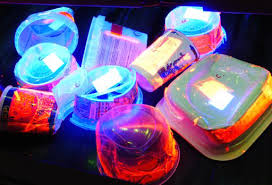Project gets funding for invisible markers to improve plastics recycling quality
Funding has been granted to a consortium from government innovations agency Innovate UK to identify new luminescent materials that can be applied invisibly to labels on plastics packaging, providing a low-cost sorting option for recyclables. The project, Plastic Packaging Recycling using Intelligent Separation technologies for Materials (PRISM), has received £772,000 (US $1 million) of funding for over two years. Part of the funding is has also been provided by the Engineering and Physical Sciences Research Council.
February 24, 2016

Funding has been granted to a consortium from government innovations agency Innovate UK to identify new luminescent materials that can be applied invisibly to labels on plastics packaging, providing a low-cost sorting option for recyclables.
The project, Plastic Packaging Recycling using Intelligent Separation technologies for Materials (PRISM), has received £772,000 (US $1 million) of funding for over two years. Part of the funding is has also been provided by the Engineering and Physical Sciences Research Council. The PRISM venture will create fluorescent materials from novel metal oxides as well as converting reprocessed powders from recycled fluorescent lamps into suitable fluorescent materials.
The PRISM venture will create fluorescent materials from novel metal oxides as well as converting reprocessed powders from recycled fluorescent lamps into suitable fluorescent materials.
The fluorescent marking technology is one of the most important developments in sorting in decades, according to recycling consultancy and lead partner in the project Nextek, a plastic recycling consultancy.
"This could be the equivalent of an invisible barcode for plastics recycling. It is a significant step forward in the sub-categorization of plastics which are sorted automatically at high speed,” said Edward Kosior, Managing Director of Nextek. “It enables new initiatives from brand-owners eager to recover their packaging as part of the circular economy. Of course, it also provides a massive impetus for new businesses in the recycling sector."
UK waste and resources charity Wrap partnered with Nextek to conduct the first phase that centered on the identification and separation trials, achieving 98% yield and 95% purity. The second phase is still underway and is looking at further optimization of the system, including new fluorescent compounds, how they react through the supply chain and if the markers get completely damaged after reprocessing.
The project group said in a statement that the fluorescent label sorting system is designed to be integrated with the current near infra-red (NIR)-based sorting systems used in materials recovery facilities. While NIR retains its important role in identifying the different polymers, this system would be triggered by an ultraviolet (UV) light source that is detected in the visible spectrum. This is within the capacity of many modern automatic sorting units.
“The UV light adds an additional, high-value layer of sorting. PRISM technology captures the unique code created by the normally invisible application-specific luminescent compounds in the label. This will allow, for instance, food-grade polymers to be distinguished from non-food-grade, black plastics to be identified and full-length shrink-sleeves to be tagged according to the underlying plastic. Brand-owners could even establish closed-loop collection of specific packaging formats.”
Wrap's Packaging Program Area Manager, Claire Shrewsbury, said: "The new technology could help boost recycling plant yields, and UK plastics recycling as a whole, with more efficient ways of sorting materials such as polypropylene packaging, high density polyethylene milk bottles and sleeved polyethylene terephthalate."
Professor Rafi Ahmad, formerly of Cranfield University but now working with Nextek, first researched fluorescent markers in the 1970s. He said: "With UK recycling targets for plastics set to rise by 2017, the country needs to do much more to optimize collection and sorting. With the PRISM technology, different combinations of a limited number of fluorescent pigments used on labels, open up cost-effective routes to high-grade sorting."
PRISM partners estimate that fluorescent inks would only add a minimal cost to the labels. The concept of fluorescent markers could also be applied to the different plastics in the Waste Electrical and Electronic Equipment and automotive recycling streams. In fact, plastics might not be the only recyclable materials to benefit from the technology.
The PRISM project includes Nextek (Project Lead), Brunel University London, Tomra Sorting, CCL Label, Mirage Inks, Wwrap, Evolve Polymers, Johnson Matthey and Enlightened Lamp Recycling (ELR).
About the Author(s)
You May Also Like


